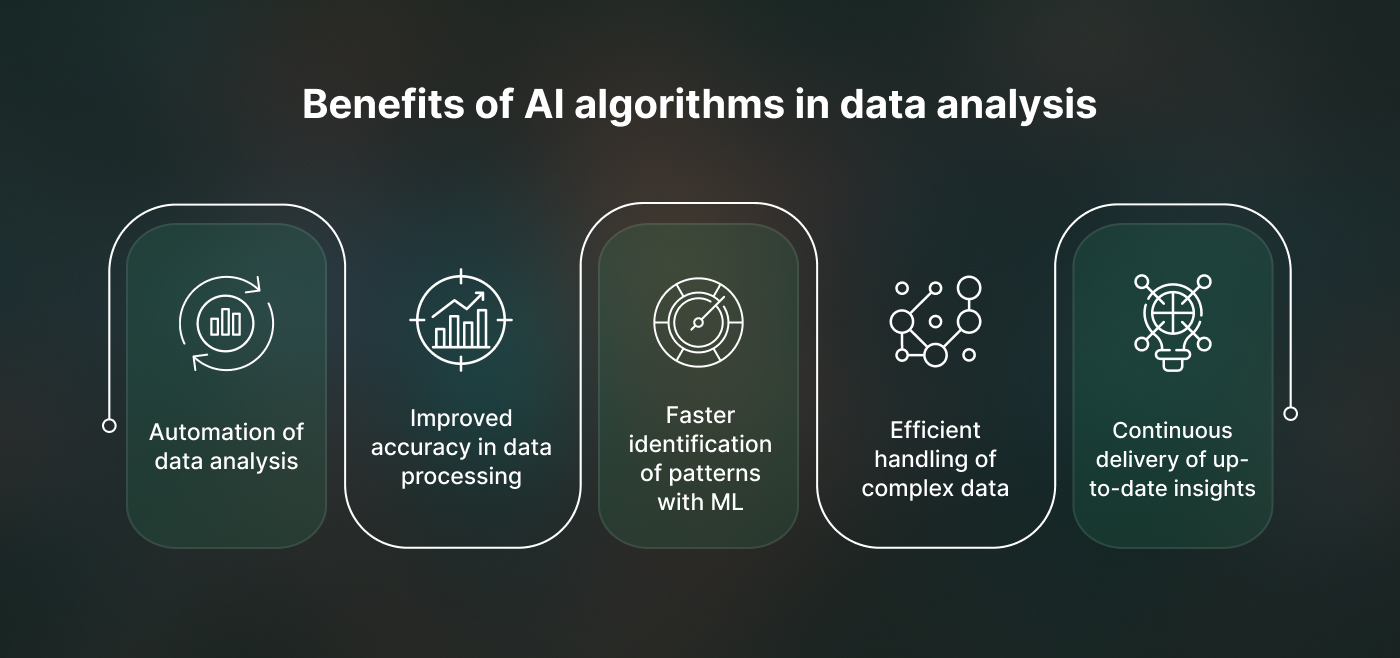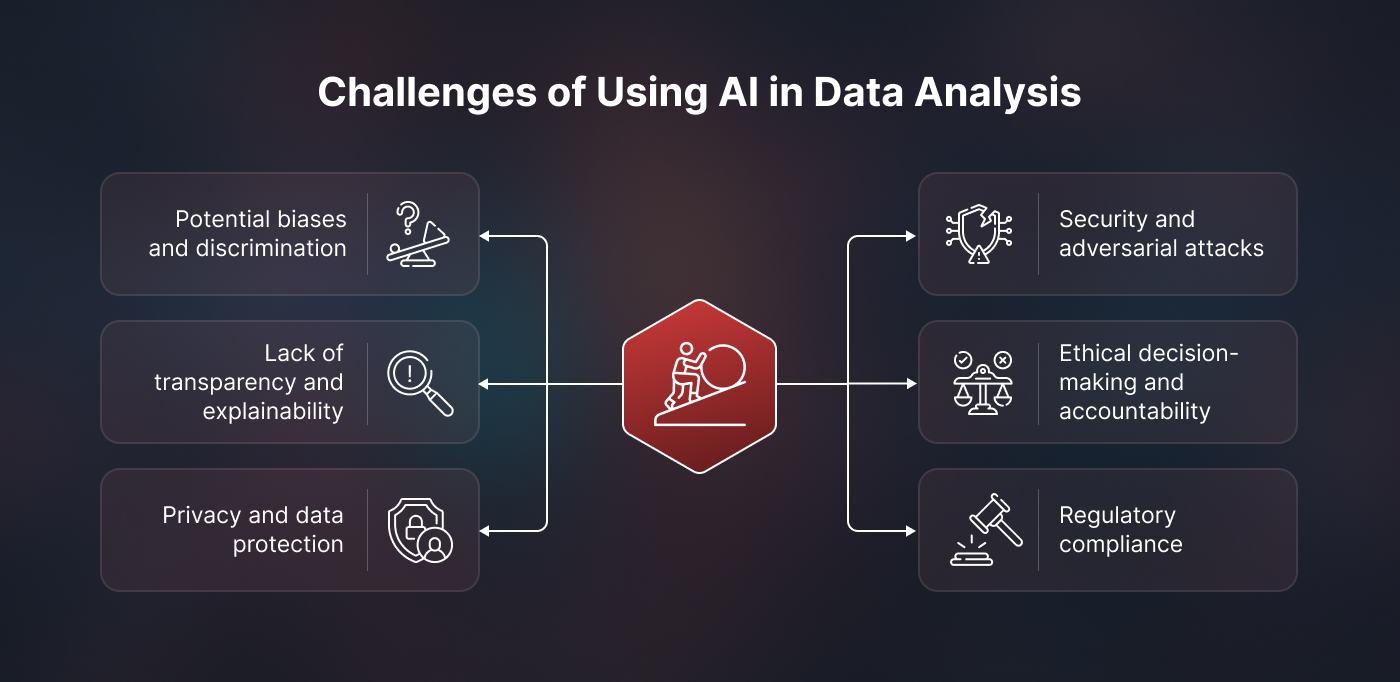As enterprise data become more complex, advanced methods for analyzing it are required. Traditional data analysis relied on manual processes and limited computing power. AI on data analytics poses to be a game-changer. AI tools, powered by machine learning and deep learning algorithms, extract valuable insights, automate repetitive tasks, and uncover hidden patterns in vast reserve of data exhibit great speed and scalability. This revolutionizes data analysis, allowing analysts to tackle complex problems more efficiently and accurately.
What is AI data analysis?
As data volumes grow, the task of data exploration becomes increasingly difficult and time-consuming. AI data analysis leverages various artificial intelligence techniques to extract valuable insights from large datasets in record time. Here are a few key techniques used in AI data analysis:
Techniques in AI data analysis
- Machine Learning Algorithms – These algorithms identify patterns or make predictions based on large datasets.
- Deep Learning – Utilizes neural networks for complex tasks such as image recognition and time-series analysis.
- Natural Language Processing (NLP) – Extracts insights from unstructured text data.
Consider a warehouse that handles and distributes thousands of packages daily. To improve efficiency, AI data analysis can help answer critical questions such as:
- How long does inventory stay in the warehouse on average?
- How much space is occupied or unoccupied on average?
- Which items are low in stock and need replenishment?
- What is the average time required to replenish stock items per product type?
- Which items have been in the warehouse for extended periods (over a month, quarter, or year)?
By identifying patterns in large datasets, AI algorithms can provide answers to these questions. This automation allows businesses to make faster, data-driven decisions.
While data scientists have long used machine learning for big data analysis, new generative AI tools now enable anyone to analyze data, even without a background in data science. This democratization of data analysis tools helps more people leverage AI to enhance decision-making processes.
Benefits of Using AI for Data Analysis

AI-enabled data analysis systems, powered by advanced algorithms and machine learning capabilities, can handle large quantities of data across various dimensions, realms, and speeds. These systems also assist in making accurate predictions by analyzing historical data. Here are some key benefits of using AI for data analytics:
Automation
AI automates many processes that were previously done manually or with rule-based systems. Machine learning algorithms can extract knowledge from data, detect patterns, and forecast outcomes without extensive human intervention or predefined rules. This automation streamlines data analysis and enhances efficiency.
Handling complex and unstructured data
Traditional data analysis methods struggle with complex and unstructured data sources like text, images, audio, and video. AI algorithms, particularly those based on deep learning techniques such as convolutional neural networks (CNN) and natural language processing (NLP) models, excel at processing such data. These AI systems can learn hierarchical representations and identify important features from unstructured data, providing valuable insights that traditional methods might overlook.
Adaptability and continuous learning
AI algorithms continuously learn and adapt as new data is gathered. This adaptability ensures that insights and predictions remain accurate and relevant, even as patterns and trends evolve over time. AI’s continuous learning capability allows organizations to stay ahead by providing up-to-date and precise data-driven insights.
The Role of AI on Data Analysis
From raw data to actionable insights, artificial intelligence (AI) plays a pivotal role in every stage of the data analytics process. Here’s a detailed look at how AI contributes to each step:
Data collection
The first step in leveraging AI for valuable insights is data collection. Extracting data from various sources is essential to provide input for AI algorithms. AI can be trained with any type of data, such as product analytics, sales transactions, web tracking, or automated data collection through web scraping.
For instance, using R, a programming language and software environment for statistical computing, you can scrape web data. R’s libraries and packages enable the extraction of real-time or updated data from websites, feeding your AI algorithms with necessary information.
Data cleansing
Clean data is crucial for accurate insights. Data cleansing, though essential, is often tedious and prone to human error when done manually. AI can automate this process, identifying outliers, handling missing values, normalizing data, and more, ensuring that the data is pristine and ready for analysis.
Data analysis
With clean, relevant data, AI models can begin analyzing and generating insights. AI excels at identifying patterns, correlations, anomalies, and trends, tasks that would take data analysts days or weeks to complete manually. However, it’s essential to be mindful of system biases since AI learns from its training data, which may contain inherent biases.
Data visualization
Presenting data in an understandable format is key to interpreting insights. Business intelligence tools, enhanced with AI capabilities, can create interactive dashboards with charts and graphs, allowing for deep exploration of data. Automating data visualization tasks with tools like ChatGPT or Luzmo’s AI-powered dashboard builder can further streamline this process.
Predictive analytics
AI outperforms traditional business analytics in forecasting. By analyzing patterns in historical data, AI can run predictive models to make accurate future predictions, such as forecasting inventory needs based on past stock levels or setting sales targets based on historical sales and seasonality.
Data-driven decision making
AI’s role in previous steps culminates in better insights, leading to more informed and faster decision-making. Powerful predictive analytics enables organizations to anticipate and avoid potential issues before they occur, ultimately improving their operations and strategic planning.
Challenges of Using AI in Data Analysis

While AI-powered data analysis offers numerous benefits, it also raises several ethical concerns and challenges. Addressing these issues is crucial to prevent unforeseen consequences. Here are some key ethical considerations and challenges in AI data analysis:
Potential biases and discrimination
AI algorithms are trained on data, and if this data is biased or lacks diversity, the models can perpetuate and amplify these biases. This can lead to discriminatory outcomes, especially in areas like lending, hiring, or criminal justice. It is essential to critically evaluate the training data, identify biases, and implement debiasing techniques to mitigate these issues.
Lack of transparency and explainability
Many AI algorithms, particularly those based on deep learning, are often referred to as “black boxes” due to their complexity and opaque decision-making processes. There is a need for developing more transparent and understandable models so that stakeholders can comprehend the reasoning behind AI decisions.
Privacy and data protection
AI-driven data analysis often involves processing large volumes of data, including potentially sensitive personal information. Misuse or mishandling of this data can lead to privacy breaches and loss of trust. Organizations must implement strict data governance policies, adhere to regulations (such as GDPR and CCPA), and establish ethical standards for data collection, storage, and processing.
Security and adversarial attacks
AI systems are vulnerable to adversarial attacks, where attackers manipulate input data to produce incorrect or harmful outputs. These attacks can cause significant damage, particularly in critical sectors like healthcare or autonomous systems. Robust security measures, such as adversarial training and testing, are necessary to protect AI systems from such threats.
Ethical decision-making and accountability
AI can be used to make crucial decisions affecting people’s lives, such as loan approvals, medical diagnoses, or criminal sentencing. These decisions must be made ethically and responsibly, ensuring fairness, non-discrimination, and human oversight. Clear regulations and accountability mechanisms are needed to prevent misuse and ensure the responsible application of AI.
Regulatory compliance
As AI technologies evolve, governments and regulatory bodies are developing frameworks and guidelines to govern their use. Organizations must stay informed about legal developments and comply with data protection laws, algorithmic accountability measures, and industry-specific AI usage standards.
While AI in data analysis presents significant opportunities, it also poses ethical challenges that must be carefully managed. By addressing biases, ensuring transparency, protecting privacy, securing against adversarial attacks, promoting ethical decision-making, and adhering to regulatory standards, organizations can leverage AI responsibly and effectively.
Popular AI Data Analysis Tools
Microsoft Power BI
Microsoft Power BI incorporates AI capabilities to enhance text data analysis. Users can enrich their data through sentiment analysis, key phrase extraction, language detection, and other features, making it a versatile tool for handling various data types.
Amazon Comprehend
Amazon Comprehend leverages ML to extract and classify information from text in documents, customer support tickets, product reviews, emails, social media feeds to deliver business-critical insights.
Tableau
Tableau offers robust AI features tailored for data scientists. While it requires some experience to get started, data analysts can perform AI-powered predictions, what-if scenario planning, and other advanced techniques. Data scientists can use statistical modeling directly within Tableau, integrating with R, Python, MATLAB, and more.
KNIME
KNIME is an open-source data science platform ideal for those new to AI tools. It offers an intuitive, drag-and-drop interface that allows data experts to design, train, and apply machine learning models easily, making it a great entry-level tool for AI experimentation.
Databricks
Databricks unifies data, analytics, and AI on a single platform, combining the functionalities of data lakes and data warehouses. This makes it an excellent infrastructure for developers to run AI applications or machine learning algorithms seamlessly.
AnswerRocket
AnswerRocket functions as an AI assistant for data analysis. It connects to various data sources, allowing users to ask questions in plain English and receive proactive insights and recommendations based on the underlying data.
Conclusion
AI revolutionizes data analytics by automating processes, managing complex and unstructured data, and continuously learning from new information. These capabilities enable businesses to make efficient, data-driven decisions, unlocking the full potential of their data.
At Gleecus TechLabs Inc., we believe that AI in data analysis is the true superpower that can enhance decision-making and uncover real value, propelling your organization to new heights.
